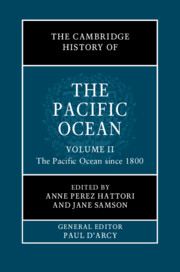Book contents
- The Cambridge History of the Pacific Ocean
- The Cambridge History of the Pacific Ocean
- The Cambridge History of the Pacific Ocean
- Copyright page
- Contents
- Figures
- Tables
- Contributors to Volume II
- Frontispiece
- General Editor’s Introduction
- Preface to Volume II
- Part VII Rethinking the Pacific
- Part VIII Approaches, Sources, and Subaltern Histories of the Modern Pacific
- Part IX Culture Contact and the Impact of Pre-colonial European Influences
- Part X The Colonial Era in the Pacific
- 49 Political Developments in the Pacific Islands in the Nineteenth Century ce
- 50 Timorese Islanders and the Portuguese Empire in the Indonesian Archipelago
- 51 Pacific Bodies and Personal Space Redefined, 1850–1960
- 52 The Pacific in the Age of Steam, Undersea Cables, and Wireless Telegraphy, 1860–1930
- 53 Latin America’s Pacific Ambitions, 1571–2022
- Part XI The Pacific Century?
- Part XII Pacific Futures
- References to Volume II
- Index
51 - Pacific Bodies and Personal Space Redefined, 1850–1960
from Part X - The Colonial Era in the Pacific
Published online by Cambridge University Press: 11 November 2022
- The Cambridge History of the Pacific Ocean
- The Cambridge History of the Pacific Ocean
- The Cambridge History of the Pacific Ocean
- Copyright page
- Contents
- Figures
- Tables
- Contributors to Volume II
- Frontispiece
- General Editor’s Introduction
- Preface to Volume II
- Part VII Rethinking the Pacific
- Part VIII Approaches, Sources, and Subaltern Histories of the Modern Pacific
- Part IX Culture Contact and the Impact of Pre-colonial European Influences
- Part X The Colonial Era in the Pacific
- 49 Political Developments in the Pacific Islands in the Nineteenth Century ce
- 50 Timorese Islanders and the Portuguese Empire in the Indonesian Archipelago
- 51 Pacific Bodies and Personal Space Redefined, 1850–1960
- 52 The Pacific in the Age of Steam, Undersea Cables, and Wireless Telegraphy, 1860–1930
- 53 Latin America’s Pacific Ambitions, 1571–2022
- Part XI The Pacific Century?
- Part XII Pacific Futures
- References to Volume II
- Index
Summary
This bold statement about the pervasive penetration of colonialism, into the most intimate spaces of life, challenges narratives of the colonial project being imposed through brute violence, and then the word of God, colonial pacification and commercial development, or ‘saving’ Indigenous societies. Post-colonial deconstruction has considered how colonialism pervaded the lives, bodies, and spaces of Pacific peoples. The ‘fatal impact’ of exogenous diseases on the Pacific has been intensely debated,2 but health history monographs tended to focus on specific islands and colonial administrations.3 Yet commonalities within and between far-flung islands reveal how colonialism introduced and imposed medical and associated regimes (such as in education and labour) and infrastructure that redefined bodies and spaces across the ocean. Discourse, power, and practices in relation to health, that aimed to ‘save the race’, mapped, classified, legislated, incarcerated, separated, excluded, nurtured, treated, vaccinated, educated, trained, and employed Pacific bodies and minds. These patterns applied throughout the tropical Pacific Islands. This chapter focuses on the British colonies (especially Fiji), and on American (mainly Guam and Hawai‘i) and New Zealand territories, and refers to some Australian and French colonies.
- Type
- Chapter
- Information
- The Cambridge History of the Pacific Ocean , pp. 490 - 513Publisher: Cambridge University PressPrint publication year: 2023



